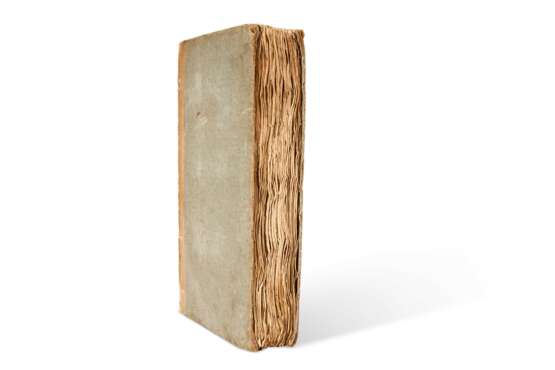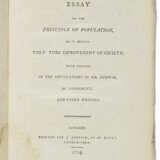ID 627523
Lot 33 | Essay on the Principle of Population
Estimate value
$ 100 000 – 150 000
First edition of Malthus's economic treatise exploring the relationship between food supply and population. The Terry copy in original boards. "The central idea of the essay—and the hub of Malthusian theory—was a simple one. The population of a community, Malthus suggested, increases geometrically, while food supplies increase only arithmetically. If the natural increase in population occurs the food supply becomes insufficient and the size of the population is checked by 'misery'—that is the poorest sections of the community suffer disease and famine" (PMM). Although his hypothesis was alarming to anyone of a benevolent nature, the Essay had great influence on the socio-economic thought of the 19th century, influencing theorists from Ricardo to Mill and Marx. It led to Quetelet's and Verhulst's precise statistical studies of population growth, and helped convince both Darwin and Wallace of the idea of "the struggle for existence." Garrison-Morton 1693; Goldsmith 17268; Kress B.3693; Norman 1431; PMM 251.
Octavo (224 x 147mm). Printed on blueish-gray paper and entirely untrimmed (dampstain to lower corner on title and last text leaf, very faint elsewhere, mild toning, paper edges sunned to cream color). Original boards, spine lettered in manuscript (chipping to spine, corners just showing, faint dampstain which is heavier on endpapers); custom morocco-backed slipcase. Provenance: Edward Parry Cox (bookplate) – Seth Sprague Terry and his son Ward E. Terry (morocco bookplate, their sale, American Art Association / Anderson Galleries, 5 December 1935, lot 274, illustrated) – Frank Capra, film director, 1897-1991 (his sale, Parke-Bernet Galleries, 27 April 1949, lot 252) – [purchased by] Julius H. Cohn – by descent to Theodore Cohn.
| Artist: | William Shakespeare (1564 - 1616) |
|---|---|
| Applied technique: | Pencil |
| Artist: | William Shakespeare (1564 - 1616) |
|---|---|
| Applied technique: | Pencil |
| Address of auction |
CHRISTIE'S 8 King Street, St. James's SW1Y 6QT London United Kingdom | |
|---|---|---|
| Preview |
| |
| Phone | +44 (0)20 7839 9060 | |
| Buyer Premium | see on Website | |
| Conditions of purchase | Conditions of purchase |













